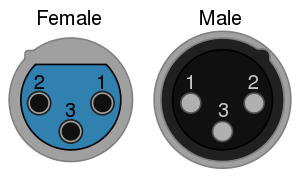
Back Digital Multiplex Catalan DMX512 Czech DMX (lys) Danish DMX (Lichttechnik) German Digital Multiplex Spanish Digital Multiplex Estonian دی ام ایکس Persian DMX (valaistus) Finnish DMX (éclairage) French DMX512 Hungarian
This article needs additional citations for verification. (February 2011) |
 XLR5 pinouts | |||
| Type | Lighting control | ||
|---|---|---|---|
| General specifications | |||
| Hot pluggable | Yes | ||
| Daisy chain | Yes | ||
| External | Yes | ||
| Cable | 2 pair, 24 AWG, 7x32 stranded, tinned copper, 6.9 left-hand twist/ft | ||
| Pins | 5 | ||
| Connector | 1 | ||
| Electrical | |||
| Max. voltage | +6 VDC per pin | ||
| Max. current | 250 mA | ||
| Data | |||
| Bitrate | 250 kbit/s | ||
| Protocol | asynchronous, half-duplex, 8N2 serial protocol over a two-wire bus | ||
| Pinout | |||
| Pin 1 | Signal Common | ||
| Pin 2 | data 1- | ||
| Pin 3 | data 1+ | ||
| Pin 4 | data 2- | ||
| Pin 5 | data 2+ | ||
 XLR3 pinouts | |||
| Type | Lighting control | ||
|---|---|---|---|
| General specifications | |||
| Hot pluggable | Yes | ||
| Daisy chain | Yes | ||
| External | Yes | ||
| Pins | 3 | ||
| Connector | 1 | ||
| Pinout | |||
| Pin 1 | Signal Common | ||
| Pin 2 | data- | ||
| Pin 3 | data+ | ||
| DMX512 over XLR3 is prohibited by section 7 of ANSI E1.11 - 2008. Despite this, 3-pin XLR has become a de facto standard within the lighting industry. See the XLR-3 pinout section for more details. | |||

DMX512 is a standard for digital communication networks that are commonly used to control lighting and effects. It was originally intended as a standardized method for controlling stage lighting dimmers, which, prior to DMX512, had employed various incompatible proprietary protocols. It quickly became the primary method for linking controllers (such as a lighting console) to dimmers and special effects devices such as fog machines and intelligent lights.
DMX512 has also expanded to uses in non-theatrical interior and architectural lighting, at scales ranging from strings of Christmas lights to electronic billboards and stadium or arena concerts. It can now be used to control almost anything, reflecting its popularity in all types of venues.
DMX512 uses a unidirectional EIA-485 (RS-485) differential signaling at its physical layer, in conjunction with a variable-size, packet-based communication protocol. DMX512 does not include automatic error checking and correction and therefore is not an appropriate control for hazardous applications,[1] such as pyrotechnics or movement of theatrical rigging. However, it is still used for such applications.[citation needed] False triggering may be caused by electromagnetic interference, static electricity discharges, improper cable termination, excessively long cables, or poor quality cables.
The DMX standard is published by the Entertainment Services and Technology Association (ESTA), and can be downloaded from its website.[2]
- ^ United States Institute for Theatre Technology -- Resources > Standards > DMX512 > DMX512 FAQ -- http://www.usitt.org/Resources/Standards2/DMX512/DMX512FAQ#a12 Archived 2011-10-20 at the Wayback Machine -- ...DMX512 is not an appropriate control protocol for hazardous applications...
- ^ "ESTA Technical Standards Program, published documents". tsp.esta.org. Retrieved 18 January 2024.